Notice
If you get a question wrong, you can still click on the other answers. This will open up hints and explanations(if available) with additional information.My personal advice: Since the exams are written, if you score less than 90% on the following MC questions, seriously reconsider your study strategies for this class.
Disclaimer: While every reasonable effort is made to ensure that the information provided is accurate, no guarantees for the currency or accuracy of information are made. It takes several proof readings and rewrites to bring the quiz to an exceptional level. If you find an error, please contact me as soon as possible. Please provide a description of the question because server may randomize the questions and answers.
Go to: Midterm II | Final
Geology (GLGY 381-UCAL) Midterm Exam I
Congratulations - you have completed Geology (GLGY 381-UCAL) Midterm Exam I.
You scored %%SCORE%% out of %%TOTAL%%. With incorrect multiple attempts your score is %%PERCENTAGE%%
Your performance has been rated as %%RATING%%
Question 1 |
A | Transported rock fragments |
B | Magmas rich in calcium carbonates |
C | Precipitation of inorganic compounds out of water due to evaporation |
D | Calcium carbonate produced as a by product of chemical weathering |
E | Hard organic parts from invertebrates |
Question 2 |
A | carbonates |
B | precipitates |
C | evaporates |
D | clastic sediments |
E | organic deposits |
Question 3 |
A | Starved ripples |
B | Planar cross-lamination |
C | Turbulent sweeps |
D | Trough cross-lamination |
E | Climbing ripples |
Question 4 |
A | False |
B | True |
Question 5 |
A | viscosity of the fluid |
B | amplitude of the wave |
C | type of fluid |
D | period of the wave |
Question 6 |
A | At the top of a moving current, the velocity is close to zero. |
B | In the middle of the profile, the velocity is close to zero. |
C | Uniformly moving fluids will have an equal instantaneous velocities regardless of depth. |
D | Deeper in the fluid higher the velocity. |
E | Deeper in the fluid lower the velocity. |
Question 7 |
A | Sheet wash |
B | Turbidity current |
C | Slump |
D | Debris flow |
E | Rock fall |
Question 8 |
A | The rock is composed of just one clast type. |
B | The rock is composed of just two or three clast types. |
C | The rock is dominated by matrix and has very few clasts. |
D | The rock is composed of highly angular clasts. |
Question 9 |
A | A. subercritical B. critical C. supcritical |
B | A. critical B. subcritical C. supercritical |
C | A. supercritical B. critical C. subcritical |
D | A. supercritical B. subcritical C. critical |
E | A. critical B. supercritical C. subcritical |
supercritical = Fr > 1 and the velocity of the stream is greater than the velocity of the surface wave.
subcritical = Fr < 1 and the velocity of the stream is lower than the velocity of the surface wave.
Question 10 |
A | True |
B | False |
Question 11 |
Description
-high velocity
-larger Reynold's number
-inertial forces dominates over the viscous forces
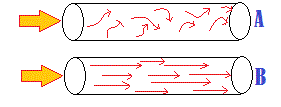
A | A |
B | It could be either A or B because the description is is insufficient. |
C | Neither |
D | B |
Question 12 |
A | low viscous forces in the folow |
B | turbulent flow |
C | gravity driven flow |
D | laminar flow |
Question 13 |
A | Flow of a fluid through a tapered tube results in an increase in velocity. |
B | Depositional sequences in very high energy environments. |
C | Settling velocity of particles in a fluid. |
D | How flow rate, density of the fluid and pathway of flow dictates type of flows. |
Question 14 |

A | NE to SE |
B | N to S |
C | NW to SE |
D | S to N |
E | SE to NW |
Question 15 |
A | False because pedogenesis is the process of erosion by both physical and chemical weathering. |
B | True |
C | False because pedogenesis is the process of creating rivers. |
D | False because pedogenesis is the process of creating soil. |
Question 16 |
A | 98% |
B | 75% |
C | 5% |
D | 90% |
E | 50% |
Question 17 |
A | Classification of the trace fossils. |
B | Study of the mode of preservation. |
C | Description of the identifiable parts. |
D | Study of behavior. |
Question 18 |

A | B |
B | C |
C | A |
Question 19 |
A | Debris flows |
B | Glacial breakups |
C | Slumps |
D | Rock falls |
E | Turbidity currents |
Question 20 |
A | True |
B | False |
Question 21 |
A | amphibole |
B | olivine |
C | quartz |
D | biotite |
Question 22 |
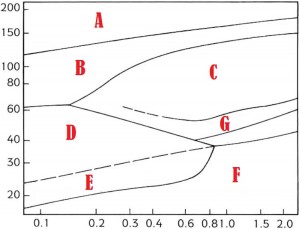
A | D |
B | B |
C | C |
D | A |
E | E |
Question 23 |
A | False |
B | Yep |
Question 24 |

A | A |
B | G |
C | F |
D | B |
E | D |
F | C |
Question 25 |
A | Above the normal sea level |
B | Abyssal zone |
C | Sandy shore (littoral zone) |
D | Bathyal zone |
E | Shelf (sublittoral zone) |
Question 26 |
A | A. bed load B. suspended load |
B | A. inertial forces driven load B. gravity driven load |
C | A. gravity driven load B. inertial forces driven load |
D | A. suspended load B. bed load |
Question 27 |

A | Neither due to incorrect representation of the internal flow direction. |
B | Neither due to incorrect representation of the initial flow direction. |
C | A |
D | B |
Question 28 |
A | A. carbonates B. silicates |
B | A. silicates B. carbonates |
C | A. mafic rocks B. felsic rocks |
D | A. felsic rocks B. mafic rocks |
Question 29 |
A | sedimentation |
B | erosion |
C | paleosols |
D | pedogenesis |
Question 30 |
A | highest velocity point of the velocity profile. |
B | (around) middle of the velocity profile. |
C | bed surface of the velocity profile. |
D | surface of the fluid. |
Question 31 |

A | B |
B | C |
C | A |
Question 32 |
A | The highest velocity is at the bed. |
B | Velocity increases as the depth increases. |
C | The lowest velocity is at the bed. |
D | At the bed, there is no slip conditions due to higher velocity. |
E | Velocity decreases as the depth increases. |
Question 33 |
A | False |
B | True |
Question 34 |
A | Base |
B | Low pH solutions in high temperature solutions |
C | Base solutions in high temperature environment |
D | High pH solutions |
E | Acids |
Question 35 |
A | Release of stress as a result of pressure decrease. |
B | Organic activities such as roots and biodegradation causing decrease in the mineral volume. |
C | Organic activities such as roots and biodegradation causing increase in the mineral volume. |
D | Increase of stress as a result of pressure increase. |
E | Hydration of minerals result in increase in volume. |
F | Freeze-thaw cycle result in change in volume. |
Question 36 |
A | Sediment is totally reworked by bioturbation |
B | A sample with few discrete traces of bioturbation |
C | Bioturbation is between 60% to 90% of the sediment bioturbated and bedding indistinct |
D | Bioturbation is between 30% and 60% of the sediment affected and bedding is distinct |
E | Bioturbation affects less than 30% of the sediment sample and the bedding is distinct |
F | Bioturbation is over 90% of sediment bioturbated, and bedding
is barely detectable |
Question 37 |
A | Dunes have interbedded cross laminations and ripples do not. |
B | Dunes are distinctly larger than ripples. |
C | Dunes form in marine environments and ripples form in non-marine river type environments. |
D | Dunes forms in turbulent waters and ripples forms in calm waters. |
Question 38 |
A | I. lower II. turbulent |
B | None of the answers are correct. |
C | I. lower II. laminar |
D | I. higher II. laminar |
E | I. zero II. turbulent |
Question 39 |
A | artificial weathering |
B | chemical weathering |
C | physical weathering |
D | biological weathering |
Question 40 |
A | tangential stress |
B | sub-normal stress |
C | super-normal stress |
D | normal stress |
E | shear stress |
Question 41 |
A | superposition |
B | Uniformitarianism |
C | lowerposition |
D | original horizontality |
E | parsimony |
Question 42 |
A | True |
B | False |
Antidunes can be formed as a result of beds deposition in phase to the surface water wave.
Question 43 |
A | rough bed velocity model |
B | smooth current velocity model |
C | laminar velocity model |
D | turbulent velocity model |
Question 44 |
A | Hydration(swelling) and dehydration(shrinking) |
B | Burial(shrinking) and exfoliation(swelling). |
C | Hydration(shrinking) and dehydration(swelling) |
D | Freezing(swelling) and thawing(shrinking). |
E | Freezing(shrinking) and thawing(swelling). |
Question 45 |
A | Deep subsurface environments under high pressures and temperatures. |
B | Deltaic environment with high sediment influx. |
C | Glacial environment where clasts are dragged across a flat surface. |
D | High energy environment with a one single direction of water flow. |
Question 46 |
A | True |
B | False |
Question 47 |
A | It transforms sedimentary rocks into metamorphic rocks |
B | It occurs under temperatures above 500 degree Celsius |
C | It transforms sediments into metamorphic rocks |
D | It transforms igneous rocks into sedimentary rocks |
E | It change the chemical and physical characteristics of sediments after the deposition |
Question 48 |
A | decreasing , decreasing |
B | increasing , increasing |
C | None of the answers are correct because it is not the acidity that is important, it is the pH. |
D | decreasing , increasing |
E | increasing , decreasing |
Question 49 |

A | C |
B | F |
C | G |
D | E |
E | D |
Question 50 |
A | a type of physical weathering caused by biogenic processes which result in breakdown of rocks/sediments. |
B | a type of chemical weathering caused by oxidation of chemical compounds within rocks. |
C | a type of erosion caused by temperature and pressure change caused by exhumation of rocks/sediments. |
D | a type of chemical weathering caused by dissociation of water into H+ and OH- ions as a result of acidifying agent. |
E | a type of physical weathering caused by water or hydrous fluids penetrate rocks/sediments and expand as a result of freezing; leads to cracks and physical breakdown of materials. |
Question 51 |
A | The relationship between an object's mass m, its acceleration a, and the applied force F is F = ma. Acceleration and force are vectors (as indicated by their symbols being displayed in slant bold font); in this law the direction of the force vector is the same as the direction of the acceleration vector. |
B | For every action there is an equal and opposite reaction. |
C | Gravitational force is proportional to the mass and acceleration due to gravity. |
D | Every object in a state of uniform motion tends to remain in that state of motion unless an external force is applied to it. |
Question 52 |
A | Abyssal zone |
B | Shelf (sublittoral zone) |
C | Above the normal sea level |
D | Bathyal zone |
E | Sandy shore (littoral zone) |
Question 53 |
A | dolostone |
B | mudstone |
C | limestone |
D | sandstone |
E | gypsum |
Question 54 |
A | saltation |
B | rolling |
C | paleoflow |
D | suspension traction |
E | sliding |
Question 55 |

A | E |
B | G |
C | F |
D | D |
E | C |
F | B |
G | A |
Question 56 |
A | A. iron rich minerals B. oxygen rich minerals |
B | A. mafic and felsic minerals B. silica rich minerals |
C | A. mafic minerals B. felsic minerals |
D | A. oceanic crust B. continental crust |
E | A. felsic minerals B. mafic minerals |
Question 57 |

A | No such thing on the diagram above. |
B | F |
C | E |
D | D |
E | C |
Question 58 |
A | temporal acceleration |
B | inertial acceleration |
C | spatial acceleration |
D | upwards acceleration |
E | gravitational acceleration |
Question 59 |
A | True |
B | False |
Question 60 |
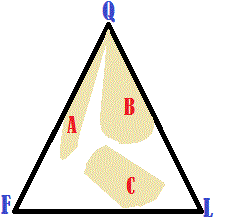
A | 98% quartz
1 % lithics
1% feldspar |
B | 50% lithics
40 % feldspar
10% quartz |
C | 98% lithics
1 % feldspar
1% quartz |
D | 60% quartz
1 % lithics
90% feldspar |
Question 61 |
A | Potential energy |
B | Flow separation |
C | Flow velocity |
D | Sediment load |
E | Gravity |
Question 62 |

A | 1. is a dune 2. is a dune |
B | 1. is a dune 2. is an antidune |
C | 1. is an antidune 2. is a dune |
D | 1. is an antidune 2. is an antidune |
Question 63 |
A | River bed environments |
B | Warm and tropical wet environments |
C | None of the answers posted here are correct. |
D | Shallow marine environments |
E | Deep marine environments |
Question 64 |

A | Left side is the stoss side and right side is the lee side. |
B | Left side has the scour region and right side is the stoss side. |
C | Left side has the scour region and right side is the lee side. |
D | Left side is the lee side and right side is the stoss side. |
E | All statements are incorrect. |
Question 65 |
A | Even though they have the similar names, they are unrelated each other because sedimentary rock is a geologic structure and sediment is a type of geologic material. |
B | Sediments are unconsolidated materials that forms at the Earth's surface while sedimentary rocks are formed as a result of burial and lithification of these sediment materials. |
C | Even though they have the similar names, they are unrelated each other because sediment is a geologic structure and sedimentary rock is a type of geologic material. |
D | Sedimentary rocks are unconsolidated materials that forms at the Earth's surface while sediments are formed as a result of burial and lithification of these sediment materials. |
Question 66 |

A | grain size in mm |
B | flow velocity in m/s |
C | flow velocity in cm/s |
D | grain size in um |
E | depth in m |
Question 67 |
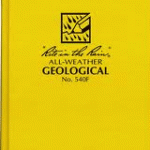
A | Physical |
B | Chemical |
C | Hydration/dehydration |
D | Simple solution |
Question 68 |
A | Matrix is formed when the clasts are deposited under high temperatures while cement is formed when clasts are deposited under low temperatures. |
B | Both terms describes a material that binds clasts but the term "matrix" is used when the rock is mostly composed of clasts while cement is used when majority of the rock is composed of fined grained materials. |
C | Matrix is the substance that binds clasts together while cement is a fined grained material that deposits within crystals. |
D | Matrix is deposited at the same time as clasts while cement forms after the deposition of sediment as precipitate. |
Question 69 |

A | A. Quartz B. Lilith fragments C. Feldspar |
B | A. Magmatic arc B. Continental block C. Recycled origin |
C | A. Continental block B. Magmatic arc C. Recycled origin |
D | A. Recycled origin B. Continental block C. Magmatic arc |
E | A. Quartz B. Feldspar C. Lilith fragments |
F | A. Continental block B. Recycled origin C. Magmatic arc |
Question 70 |

A | The pressure from above is much higher causing the grains to push hard against the bed. |
B | The stream lines(red lines) converging at the yellow arrow cause the velocity to increase significantly(at that point). |
C | The pressure right above the yellow arrow is much lower than the pressure near the black rocks/sediments. |
D | The lift at the yellow arrow is caused by the high pressure at the top caused by converging streamlines. |
E | The stream lines(red lines) converging at the yellow arrow cause the velocity to decrease significantly(at that point). |
Question 71 |
A | High velocity currents. |
B | Low velocity currents. |
C | Medium velocity currents. |
D | Fluctuating velocity currents. |
Question 72 |
A | Dry climates with long periods of droughts |
B | Dry climates with year-round permafrost |
C | Temperate climate with long cold winters and short warm summers |
D | Deep sea ocean beds with rich organic matter |
E | Humid climates |
Question 73 |
-high viscosity
-poorly sorted grains
-often larger clasts are separated by fine grained materials
-low Reynolds number and considered as a laminar flow
-low velocity (40-50 km/h)
A | Debris flow |
B | Grain flow |
C | Liquified flow |
D | Turbidity flow |
Question 74 |
h(D) = 55 m
g = 9.81 m/s2
u = 33 m/s
A | 0.06116 |
B | 1.95 |
C | 1.42 |
D | 2.37 |
E | 0.6116 |
Question 75 |
A | Minerals with very high densities resulting deposition at the bottom of a flow. |
B | Minerals that formed as a result of magmatic processes that occurs under water. |
C | Minerals that replaces (take others' place) other minerals during sedimentation. |
D | Minerals that are formed as a result of erosion due to chemical weathering. |
E | Minerals that primarily formed from organic materials. |
Question 76 |
A | Critical flow |
B | Hydraulic jump |
C | Gradient change |
D | Change in flow regime |
E | Change in normality |
Question 77 |
A | Debris flow |
B | Turbidity current |
C | Liquified flow |
D | Grain flow |
Question 78 |
A | True |
B | False |
Question 79 |
A | Borings are created by pushing the grains to walls of the structure and boring are created by mechanically/chemically cutting the grains. |
B | Borings are trace fossils and burrows are body fossils. |
C | I have no freaking clue what the hell you asking about. |
D | Burrows are trace fossils and borings are body fossils. |
E | Burrows are created by pushing the grains to walls of the structure and borings are created by mechanically/chemically cutting the grains. |
F | Burrows and borings are created by two distinct type of creatures that in burrows the sediments are removed mechanically and in borings the sediments are dissolved chemically. |
Question 80 |
A | False |
B | True |
Question 81 |
A | sedimentary |
B | native |
C | metamorphic |
D | authigenic |
E | detrital |
Question 82 |
A | An assemblage of trace fossils that provides an indication of the palaeoenvironment. |
B | A sub set of beds and laminations that is defined by certain depositional structures. |
C | A a body of rock with specified mineralogical characteristics. |
D | A type of depositional environment that provides the best suitable conditions for organisms to thrive. |
E | A type of trace fossils created by echinoids. |
Question 83 |
A | denudation |
B | physical weathering |
C | erosion |
D | chemical weathering |
Question 84 |
A | Point contacts |
B | Concavo-convex contacts |
C | Long contacts |
D | Sutured contacts |
E | Subrounded contacts |
Question 85 |
A | Significant density contrast |
B | Gravity: hard sediments sinking into soft underlying sediments |
C | Pressure: soft water-bearing sediments escaping through overlying sediments |
D | High volume sediment loads |
Question 86 |
A | Under current ripples |
B | Under high-density turbidity currents |
C | Within oxbow lakes |
D | Under low- to medium-density turbidity currents |
E | Within river deltas |
Question 87 |
A | Differential lateral compaction within bed forms resulting high pressures between bed contacts. |
B | Differential pressure-temperature gradient that increases with depth. |
C | Extreme pressure concentrated at the contacts between grains within sediments. |
D | High pressures excreted on sediments from both through uplift and loading processes. |
E | Extreme temperatures and pressures between different sediment successions. |
Question 88 |
A | ore deposits |
B | evaporites |
C | clastic deposits |
D | chemical deposits |
E | carbonates |
Question 89 |
A | True |
B | False-it should be other way around. |
Question 90 |
A | Escape |
B | Grazing |
C | Resting |
D | Feeding |
E | Dewlling |
F | Crawling |
Question 91 |

A | False |
B | True |
Question 92 |
A | Paleogeology |
B | Paleotracology Hint: LOL What the hell? |
C | Ichnology |
D | Genology |
Question 93 |
A | True |
B | False |
Question 94 |
A | Semi- relief structures are preserved within a single type of sediment while full-relief structures are preserved at an interface between two strata. |
B | Full relief structures are preserved as 2D structures while semi-relief structures are preserved as 3D structures. Both are preserved within a single type of sediment. |
C | Full relief structures are partially preserved within a single type of sediment while semi-relief structures are fully preserved at an interface between two strata. |
D | Full relief structures are preserved within a single type of sediment while semi-relief structures are preserved at an interface between two strata. |
Question 95 |
A | Salt Diapirs |
B | Pore waters |
C | Pressure dissolution |
D | Geostatic pressure |
Question 96 |
A | Stoss side of ripples |
B | Within channels |
C | At the mouth of rivers |
D | Lee side of ripples |
E | Between dunes |
Question 97 |
A | ~ 10 degrees |
B | ~ 50 degrees |
C | ~ 100 degrees |
D | ~ 90 degrees |
E | ~ 30 degrees |
Question 98 |
A | Velocity increases as the depth increases. |
B | It is difficult to determine the velocity hence we heavily relies on speed of flowing rivers for analysis. |
C | The highest velocity is at the bed. |
D | At the bed, there is no slip conditions due to lower velocity. |
Question 99 |
A | crawling |
B | fighting |
C | dwelling |
D | feeding |
E | extractions(pooping) |
Question 100 |
A | High energy and high sedimentation environments. |
B | Low energy and high sedimentation environments. |
C | High energy and low sedimentation environments. |
D | Low energy and low sedimentation environments. |
Question 101 |
A | Bioturbation is caused by plants. Bioerosion is caused by animal activities. |
B | They are the same except Bioturbation is the British English word for Bioerosion(US-English) |
C | Bioturbation is the reworking of soils and sediments by animals or plants. Bioerosion is caused by mechanically or chemically cutting/removing the grains by organisms. |
D | Bioerosion is the reworking of soils and sediments by animals or plants. Bioturbation is caused by mechanically or chemically cutting/removing the grains by organisms. |
Question 102 |
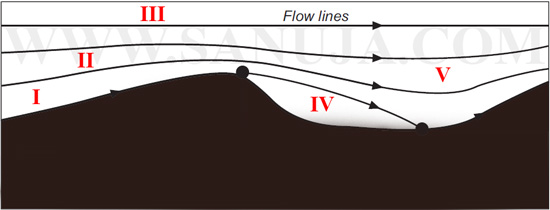
A | Position II just above the ripple |
B | Position IV in the lee side of the ripple |
C | Position I in the stoss side of the ripple |
D | Position III where the flow rate is consistent and smooth |
E | Position V between two ripples |
Question 103 |
A | At the base of the sourced region (very bottom) |
B | Below hemipelagic mud |
C | Below massive/rapid deposition |
D | Within the upper flow regime |
E | None of the answers are correct |
Question 104 |
A | True |
B | False |
Question 105 |
A | Calcium Feldspars |
B | Muscovite mica |
C | Olivine |
D | Pyroxene |
E | Kaolinite |
← |
List |
→ |
| 1 | 2 | 3 | 4 | 5 |
| 6 | 7 | 8 | 9 | 10 |
| 11 | 12 | 13 | 14 | 15 |
| 16 | 17 | 18 | 19 | 20 |
| 21 | 22 | 23 | 24 | 25 |
| 26 | 27 | 28 | 29 | 30 |
| 31 | 32 | 33 | 34 | 35 |
| 36 | 37 | 38 | 39 | 40 |
| 41 | 42 | 43 | 44 | 45 |
| 46 | 47 | 48 | 49 | 50 |
| 51 | 52 | 53 | 54 | 55 |
| 56 | 57 | 58 | 59 | 60 |
| 61 | 62 | 63 | 64 | 65 |
| 66 | 67 | 68 | 69 | 70 |
| 71 | 72 | 73 | 74 | 75 |
| 76 | 77 | 78 | 79 | 80 |
| 81 | 82 | 83 | 84 | 85 |
| 86 | 87 | 88 | 89 | 90 |
| 91 | 92 | 93 | 94 | 95 |
| 96 | 97 | 98 | 99 | 100 |
| 101 | 102 | 103 | 104 | 105 |
| End |
Credits: Based on the excellent class notes provided by, Dr. Melissa Giovanni during Fall 2012.
FAQ | Report an Error
Some of the Lab Midterm sample images | Click here
Concepts and Additional Questions for Fall 2012 Midterm I
Important!
↑ Some of these are already in the exam type questions in the quiz(above) ↑
Answers to these will NOT be posted. These are based on lecture notes!
-velocity profile; what is idealized modal’s limitations; where is the viscous sublayer and what is it
-bed formation; shape of the bed, x-beds, directional flows
-bed load vs suspended load
-Stoke’s law and the settling velocity
-flow separation concepts; eddy; stoss/lee with respect to x-beds in dunes and anti-dunes; water surface in or out of phase of bed formation
-unidirectional flow vs ocillating flow; be able to draw and describe the differences between them; wave base “feel my bottom”.
-type of sediment gravity flows; debris flow; grain flow; liquefied flow (remember that debris flow and liquefied flow are similar in operation, but different in terms of size of rocks/grains involved.
Dr. Spila’s stuff
-4 steps involving accurately identifying fossils; preservation, description, behaviour, classification(we don’t have to know how to name them)
-What is ichnology
-difference between biotrubation and bioerrosion; which is the most common type; what is the formula for degree of bioturbation
-what are borings and what are borrows
-6 major common categories of behaviours and their reliefs; crawling(semi), resting(semi), feeding(full), gazing(semi), dewlling(full), escape(full).
-meniscae and few other definitions
-preservation differences between full and semi-relief
